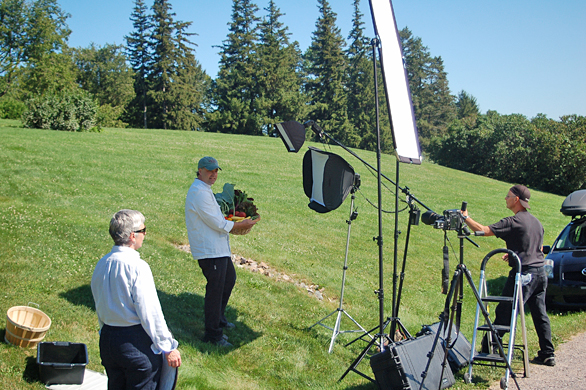In 30 years as a designer, I have strategized photo content with clients, worked on composition, product position and propping, art-directed photographers, and worked with images in every shape, size, format and quality. With the advent of digital, I became a professional photographer too, shooting food, products, high end furniture, wind turbines, architecture, events, executive portraits and more. Seven years of experience improving this skill set has given me a clearer picture of how professional quality design informs photography and vice versa. And I’ve learned a lot about quality, quantity, costs, and common sense.

Everyone’s a Photographer
Now that anyone with a smartphone, point-and-shoot, tablet or cheap DSLR can take a decent picture, we should be awash in high quality photography. Unfortunately, quantity or capability does not equal professional quality. The more times business owners settle for quick iPhone snapshots of their product, people or service, the less we expect from photography, and the less we understand what is involved in taking a great photograph—the essentials of composition, expression, authenticity, color, feel and tone; the technical skills of lighting, exposure, white balance, dynamic range, depth of field, ISO, shutter speed, histograms and resolution. Many times I have shown up at a shoot with my SUV full of equipment, and heard some variation of “I had no idea so much was involved.” And even though I am an admitted equipment junkie, I know strategic image creation is more about what you shoot and how you see, than the equipment you use.
Hire a Pro or use Stock Photography?
If your marketing strategy involves photography, and you know a smartphone snapshot is not going to cut it, the other two options are: hire a professional, or use existing stock photography. If you need a unique image with multiple specific criteria, it may be a waste of time to try to find exactly what you need by searching through stock photos online. Even if you find something close, you don’t want a photo that may be used by another company. This can cause confusion, dilute your brand, give your customers the impression you cut corners, or in the worst case, so clearly scream ‘stock photo’ that your ad or brochure does not resonate with your audience. If you need your product or food photographed, you probably won’t be using stock. Ideally, you’ll hire a specialist –– a studio product photographer or a food photographer —— to show your unique product or mouth-watering food in the best possible light. Need pictures of people? Hire a professional with experience in portraits, lifestyle, sports, glamor, etc., and pay attention to clothing style, expression, tone, look and feel, demographics—all affect how your customers relate to the marketing message.
Online Stock: Cheaper! Faster! Better?
In the old days, if you wanted a stock photo, it meant searching through hundreds of pages of glossy catalogs, and hundreds of dollars. Now you can search by keyword and usually get something fast and cheap, though don’t forget to check your usage and licensing terms. The $10 general purpose photo has become a staple of professional design. Whatever my subject, I can find several shapes, sizes and styles in an online stock photo house. In ten minutes I have the perfect feel, tone, and lighting to complement my design. Great, right? As a designer I enthusiastically holler “yes!” As a photographer, however, I find it troubling that the industry has devolved into a business model based on a large quantity of amateur content that may eventually make it difficult for professional commercial photographers to survive. Quality will suffer for everyone if the “norm” becomes settling for something that’s just good enough, rather than expecting something new and innovative.

Author on magazine cover photo shoot. In direct sunlight, using scrim to avoid harsh lighting on subject’s face.
Point-and-shoot photo courtesy of Rosalyn Graham, Shelburne Farms.
The Bigger Picture
As we strategically craft a sophisticated, well-researched campaign that uses photography, we need to understand when to hire the right people for the right job, or when to put more effort into finding the perfect stock image. A great photograph can make a message or product sing, while an average image may fall flat and fail to reinforce your concept with that spark of magic. As technology continues to provide better, cheaper cameras, we will see more and more mediocre images, but as the art of image creation evolves and reaches new levels of maturity, deeper, more imaginative, more beautiful and surprising images emerge. It’s up to us to keep our standards up and not be swayed by quantity versus quality, not to settle for okay when we can achieve great.




Photography, Quality and Design: Should You hire a Pro or Use Stock? | Change Conversations http://t.co/lbGGPwCh